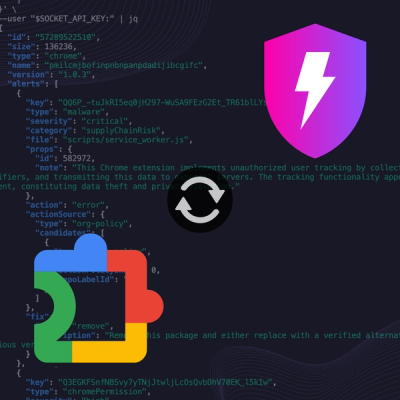
Product
Socket Now Protects the Chrome Extension Ecosystem
Socket is launching experimental protection for Chrome extensions, scanning for malware and risky permissions to prevent silent supply chain attacks.
@hyperapp/render
Advanced tools
Render Hyperapp to an HTML string with SSR and Node.js streaming support
 Hyperapp Render
Hyperapp RenderA Hyperapp higher-order app
that allows you to render views to an HTML string.
Our first example is an interactive app from which you can generate an HTML markup. Go ahead and try it online.
import { h, app } from 'hyperapp'
import { withRender } from '@hyperapp/render'
const state = {
text: 'Hello'
}
const actions = {
setText: text => ({ text })
}
const view = (state, actions) => (
<main>
<h1>{state.text.trim() === '' ? '👋' : state.text}</h1>
<input value={state.text} oninput={e => actions.setText(e.target.value)} />
</main>
)
const main = withRender(app)(state, actions, view)
main.toString() // => <main><h1>Hello</h1><input value="Hello"/></main>
main.setText('World') // <= any sync or async action call
main.toString() // => <main><h1>World</h1><input value="World"/></main>
Looking for a boilerplate? Try Hyperapp Starter with pre-configured server-side rendering and many more.
Using npm:
npm install @hyperapp/render --save
Or using a CDN like unpkg.com or jsDelivr with the following script tag:
<script src="https://unpkg.com/@hyperapp/render/hyperapp-render.min.js"></script>
You can find the library in window.hyperappRender.
We support all ES5-compliant browsers, including Internet Explorer 9 and above,
but depending on your target browsers you may need to include
polyfills for
Set,
Map and
Object.assign
before any other code.
The library provides a few functions which you can use depending on your needs or personal preferences.
import { withRender, renderToString, renderToStream } from '@hyperapp/render'
const main = withRender(app)(state, actions, view, container)
main.toString() // => <string>
renderToString(<Component />) // => <string>
renderToString(view, state, actions) // => <string>
main.toStream() // => <stream.Readable> => <string>
renderToStream(<Component />) // => <stream.Readable> => <string>
renderToStream(view, state, actions) // => <stream.Readable> => <string>
Note: functions toStream and renderToStream are available in
Node.js environment only (v6 or newer).
The library exposes three functions. The first of these is withRender high-order function,
which adds the toString action to be able to render your application to an HTML string at any given time.
This can be useful for server-side rendering or creating HTML snippets based on current application state.
import { h, app } from 'hyperapp'
import { withRender } from '@hyperapp/render'
const state = { name: 'World' }
const actions = { setName: name => ({ name }) }
const view = (state, actions) => <h1>Hello {state.name}</h1>
const main = withRender(app)(state, actions, view)
main.toString() // => <h1>Hello World</h1>
main.setName('Hyperapp') // <= any sync or async action call
main.toString() // => <h1>Hello Hyperapp</h1>
The second renderToString function generates HTML markup from any of your views without
app initialization. That could be useful to generate HTML markup from static views.
import { renderToString } from '@hyperapp/render'
const Component = ({ name }) => <h1>Hello {name}</h1>
renderToString(<Component name="World" />)
// => <h1>Hello World</h1>
The last renderToStream function and toStream equivalent return a
Readable stream that outputs an HTML string.
The HTML output by this stream is exactly equal to what toString or renderToString would return.
They are designed for more performant server-side rendering and here are examples how they could be used
with Express or Koa:
app.get('/', (req, res) => {
res.write('<!doctype html><html><head>')
res.write('<title>Page</title>')
res.write('</head><body><div id="app">')
const main = withRender(app)(state, actions, view)
const stream = main.toStream()
stream.pipe(res, { end: false })
stream.on('end', () => {
res.write('</div></body></html>')
res.end()
})
})
app.get('/', (req, res) => {
res.write('<!doctype html>')
const stream = renderToStream(
<html>
<head><title>Page</title></head>
<body>
<div id="app">{view(state, actions)}</div>
</body>
</html>
)
stream.pipe(res)
})
The library automatically escapes text content and attribute values of virtual DOM nodes to protect your application against XSS attacks.
However, it is not safe to allow "user input" for node names or attribute keys because the library does not reject injection attack on markup due to performance reasons. See:
const Node = 'div onclick="alert()"'
renderToString(<Node title="XSS">Hi</Node>)
// => <div onclick="alert()" title="XSS">Hi</div>
const attributes = { 'onclick="alert()" title': 'XSS' }
renderToString(<div {...attributes}>Hi</div>)
// => <div onclick="alert()" title="XSS">Hi</div>
const userInput = '<script>alert()</script>'
renderToString(<div title="XSS" innerHTML={userInput}>Hi</div>)
// => <div title="XSS"><script>alert()</script></div>
Hyperapp Render is MIT licensed. See LICENSE.
[2.1.0] - 2018-07-11
FAQs
Render Hyperapp to an HTML string with SSR and Node.js streaming support
The npm package @hyperapp/render receives a total of 6 weekly downloads. As such, @hyperapp/render popularity was classified as not popular.
We found that @hyperapp/render demonstrated a not healthy version release cadence and project activity because the last version was released a year ago. It has 6 open source maintainers collaborating on the project.
Did you know?

Socket for GitHub automatically highlights issues in each pull request and monitors the health of all your open source dependencies. Discover the contents of your packages and block harmful activity before you install or update your dependencies.

Product
Socket is launching experimental protection for Chrome extensions, scanning for malware and risky permissions to prevent silent supply chain attacks.

Product
Add secure dependency scanning to Claude Desktop with Socket MCP, a one-click extension that keeps your coding conversations safe from malicious packages.

Product
Socket now supports Scala and Kotlin, bringing AI-powered threat detection to JVM projects with easy manifest generation and fast, accurate scans.